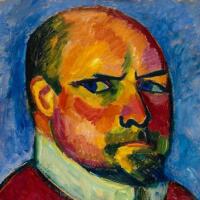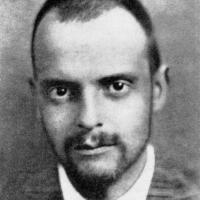About the Der Blaue Reiter Artist Group

What is Der Blaue Reiter?
“Art today is moving in directions of which our forebears had no inkling,” wrote Franz Marc in 1912. “The Horsemen of the Apocalypse are heard galloping through the air; artistic excitement can be felt all over Europe – new artists are signaling to one another from all sides; a glance, a touch of the hand, is enough to convey understanding.” The previous year, Marc joined with Wassily Kandinsky and a number of other German and Russian émigré artists to form Der Blaue Reiter (The Blue Rider): a group with diverse aesthetic approaches – variously inspired by Post-Impressionism, early Cubism, the art of medieval Europe and folk art of the world – but with a united belief in the spiritual power of color.

The first roilings of the Great War in 1914 foretold the end of the group after only three years, but its influence would reverberate across the generations.

What Are the Stylistic Characteristics of Der Blaue Reiter?
The catalogue of the first Der Blaue Reiter exhibition in 1911 set forth the group’s ecumenical aim to “propagate…not one precise and special form, but…in the variety of the forms represented to show how the inner wish of the artists expresses itself.” Franz Marc’s work is recognizable for it frequent portrayal of animals – especially horses – fractured into cubist-like planes and rendered in vibrant primary colors. Kandinsky’s paintings from this period are more improvisational, featuring large expanses of color freed from the constraint of lines. Meanwhile, Albert Bloch, the only American artist associated with Der Blaue Reiter, painted ethereal human figures wafting through fructuous landscapes, and August Macke interpreted architecture and streetscapes with Orphist and Fauvist inflections.

A Reunion: Die Blaue Vier
In 1923, Kandinsky, Feininger, Klee and von Jawlensky regrouped to form Die Blaue Vier (The Blue Four), and would exhibit and lecture together in the United States and Mexico over the ensuing decade. Die Blaue Vier was the brainchild of painter and dealer Galka Scheyer, who was born into a Jewish family in Germany and settled in California in the 1920s. Her industrious promotion of Die Blaue Vier – which included lending paintings to Hollywood movie sets – did much to broaden the influence of European modernism in North America, with John Cage, Diego Rivera, Walter Conrad Arensberg, Edward Weston and Frank Lloyd Wright among those who became conversant with this rich body of work through Scheyer.
What is the Legacy of Der Blaue Reiter?
“I am sure of one thing,” wrote Marc to Kandinsky in 1911. “Many…young people full of energy will…be fired by enthusiasm for [Der Blaue Reiter Almanach] and will judge the world in accordance with it.” Indeed, despite the group’s short tenure, the group and its singular journal had a profound influence on subsequent generations of artists. Among those 20th-century painters who acknowledged a debt to Der Blaue Reiter included the Hungarian Béla Kádár, the American Marsden Hartley, the Austrian Oskar Kokoschka, and the Swiss Johannes Itten. More broadly, Der Blaue Reiter was in the vanguard of the movement towards expressionism and abstraction, leading the way for Gorky, Pollock, Basquiat and their proliferation of artistic heirs today.
The work of Der Blaue Reiter can be seen in countless major museums worldwide, including the Museum of Modern Art in New York, Kunstsammlung Nordrhein-Westfalen in Düsseldorf and the Albertina in Vienna. Also worthy of note is the August-Macke-Haus in Bonn and the Franz Marc Museum in Kochel am See, both of which feature permanent holdings from the artists’ estates as well as temporary exhibitions.
Timeline & History

Signet of the Neue Künstlervereinigung München 1909The Neue Künstlervereinigung München (Munich New Artist's Association) is founded by Wasily Kandinsky and others
Wassily Kandinsky circa 1913 1910Kandinsky pens his seminal treatise “On the Spiritual in Art” which promoted abstract art and in particular the non-denotative use of color as a practice capable of metaphysical revelation
Wassily Kandinsky, The Last Judgment, 1912 1911Wassily Kandinsky and Franz Marc lead the formation of a new group, Der Blaue Reiter, after Kandinsky's painting The Last Judgement is rejected from an exhibition; the group's first show is held at the Moderne Galerie Tannhäuser
Wassily Kandinsky, cover of Der Blaue Reiter almanac, circa 1912 1912Der Blaue Reiter Almanach is published by Piper, Munich; edited by Kandinsky and Marc, it contains reproductions of 140 artworks plus essays by Arnold Schoenberg, Auguste Macke, and others
Herwarth Walden, German expressionist artist and art expert, photographed in 1910 1913The artists of Der Blaue Reiter participate in an exhibition in Berlin organized by Herwarth Walden and his gallery Der Sturm
German troops mobilize for World War I, 1 August 1914 (Credit: German Federal Archive (Deutsches Bundesarchiv) as part of a cooperation project) 1914The outbreak of the Great War forces Kandinsky and several other Russian émigrés to leave Germany; August Macke is killed in action in Champagne that September
Paul Klee, Death for the Idea, 1915 1915Distressed by Macke's death, Paul Klee, who had been loosely affiliated with the Blaue Reiter group from late 1911, creates his iconic lithograph Der Tod für die Idee (Death for the Idea)
Franz Marc, 1910 1916Franz Marc is killed in action in Braquis
Artists
Wassily Kandinsky and Franz Marc are regarded to be the leaders of the group, with August Macke, Alexej von Jawlensky, Marianne von Werefkin, Gabriele Münter, Lyonel Feininger and Albert Bloch also being key figures, and Paul Klee serving as an important but independent affiliate. The group's first exhibition also featured paintings by Henri Rousseau and Robert Delaunay, and the Almanach reproduced work by Paul Gauguin, Vincent Van Gogh, folk art from Africa and the South Pacific, medieval German graphics and drawings by children.
Der Blaue Reiter at Auction
Sell
Have Something to Sell?
Have Something to Sell?
Get Started























